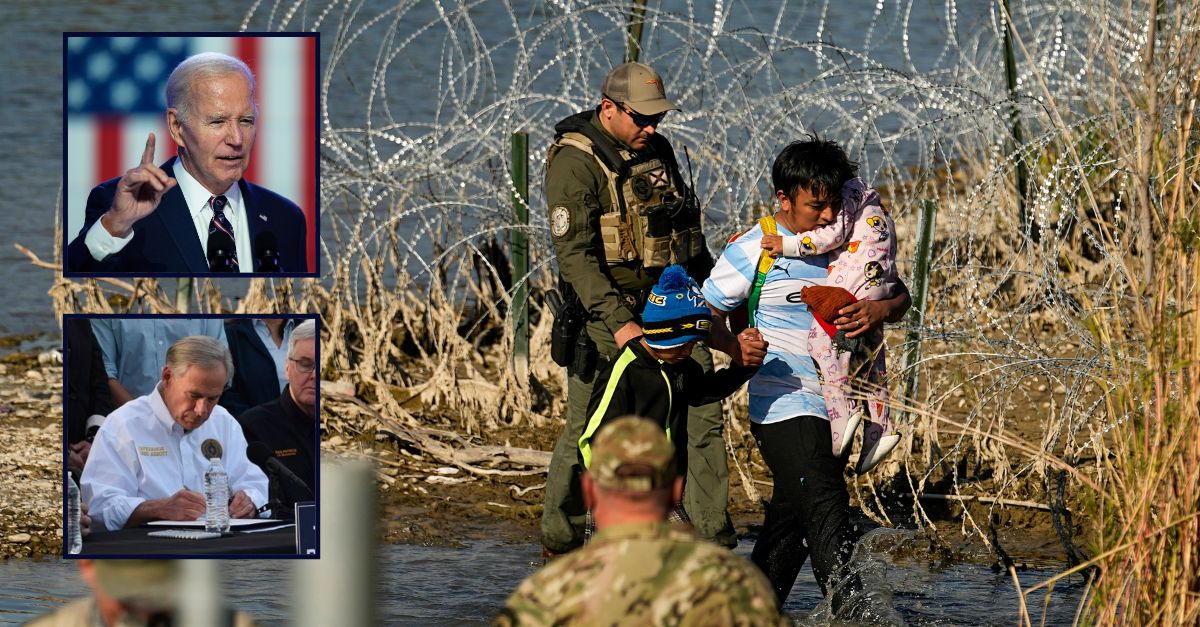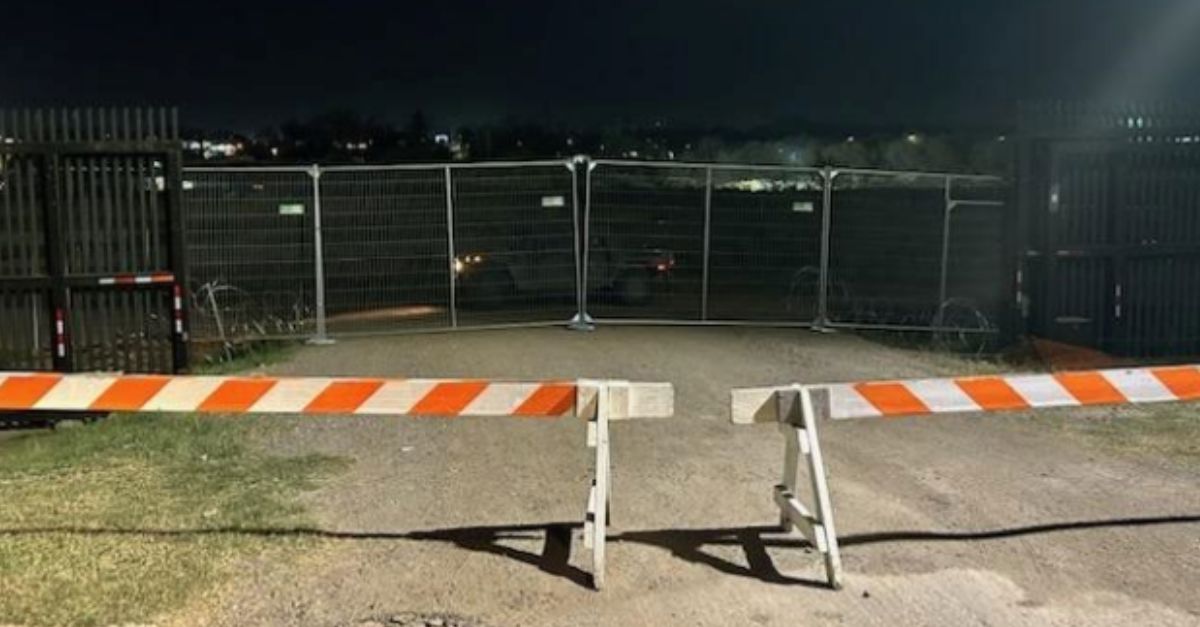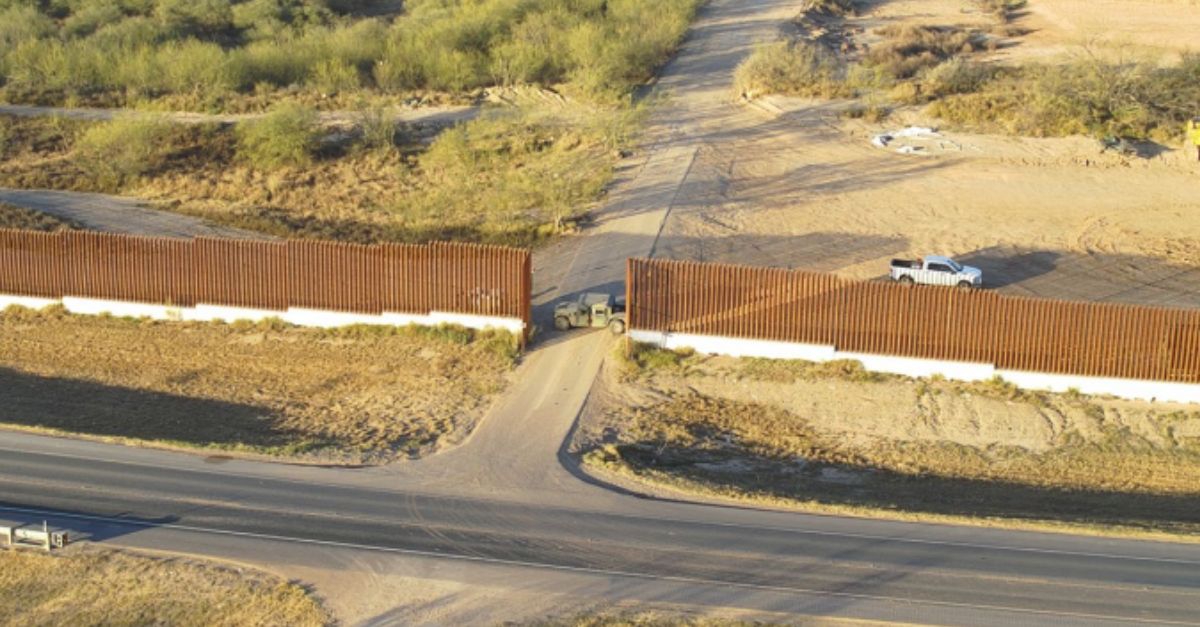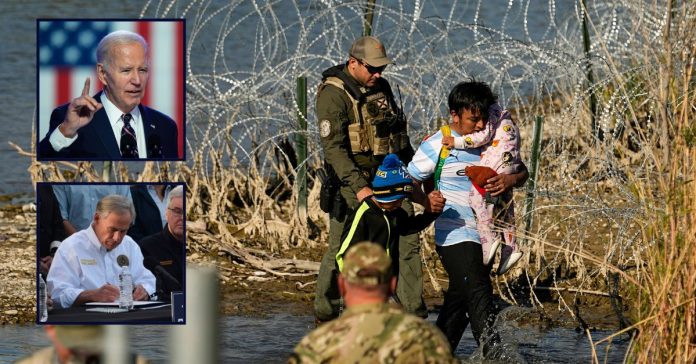
Migrants are taken into custody by officials at the Texas-Mexico border, on Wednesday, Jan. 3, 2024, in Eagle Pass, Texas. (AP Photo/Eric Gay). Inset top: President Joe Biden speaks in Blue Bell, Pa., Friday, Jan. 5, 2024. (AP Photo/Matt Rourke). Inset bottom: Texas Gov. Greg Abbott signs three bills into law at a border wall construction site in Brownsville, Texas, Dec. 18, 2023, that will broaden his border security plans and add funding for more infrastructure to deter illegal immigration. (AP Photo/Valerie Gonzalez, File).
The state of Texas is allegedly blocking federal access to border crossings, putting both migrants and federal Border Patrol agents at risk.
In a filing before the U.S. Supreme Court on Friday, the Department of Homeland Security accused the Texas National Guard of blocking Customs and Border Patrol workers from viewing and accessing key points along a stretch of the Texas-Mexico border along the Rio Grande, where migrants have been known to cross.
The filing is the latest legal move in the escalating fight between President Joe Biden, a Democrat, and Republican Gov. Greg Abbott over how to handle migrant crossings at the border between Mexico and the Lone Star State. As Law&Crime previously reported, the Biden administration is challenging a new law in Texas that allows state police to arrest and prosecute people crossing the border illegally.
The conservative 5th Circuit Court of Appeals had ordered Texas to remove its floating barrier of buoys from the Rio Grande and a lower federal court sided with the federal government in a ruling that allowed Border Patrol agents to continue cutting concertina wire that Texas installed on the banks of the Rio Grande.
The 5th Circuit did, however, put a temporary pause on the wire ruling while the appeal progresses. The Biden administration appealed that injunction, and on Friday alleged that Texas has been interfering with the federal government’s work in the area.
“The government filed its reply at approximately 5:00 p.m. on January 10. Hours later, Border Patrol learned that Texas National Guard members had begun erecting new concertina wire barriers, adding to others along an approximately 2.5-mile stretch of the border at issue in this case,” said the filing, signed by Solicitor General Elizabeth Prelogar (citations omitted). “Texas also erected new fencing, located further inland than the original concertina wire. That fencing further restricts Border Patrol’s ability to reach the river in particular areas.”
Texas blocked an area of Shelby Park, “which contains the boat ramp from which Border Patrol routinely launches the patrol boats it uses on this stretch of the Rio Grande,” the government alleges. “It also includes the staging area that Border Patrol has used to evaluate and begin inspecting migrants that it has apprehended along this stretch of the border.”
The filing detailed the exchange between agents as federal Border Patrol realized that its access had been abruptly cut off (citations omitted):
Border Patrol agents in a vehicle towing a boat to launch on the boat ramp requested access to Shelby Park, but the Texas National Guard refused to permit them to access the area. Border Patrol agents likewise requested access to the staging area and Texas National Guard refused. In addition, prior to the evening of January 10, Border Patrol agents were able to drive trucks with mounted surveillance equipment to various locations in this area. Those trucks were used to maintain visibility and awareness of activity along this stretch of the river and border. But the Texas National Guard has now blocked Border Patrol’s access to the area, rendering its agents unable to place mobile surveillance trucks. Border Patrol’s ability to view this portion of the border is now limited to a narrow sliver from a single surveillance camera located outside of the newly fenced area.
According to the Department of Homeland Security, “the new wire, fencing, and blocked access points effectively prohibit Border Patrol agents from accessing or getting near the border along this 2.5-mile stretch of the river.”
Texas’ prior assertion that Border Patrol agents could still access the border by boat or road without cutting the wire is no longer accurate, Prelogar alleges.
“[S]ince the evening of January 10, that is not the case,” the filing says. “The boat ramp that Texas has blocked off is the only safe and operationally practical boat ramp with access to the relevant portion of the river.”

According to the Biden administration, this is a photograph taken the evening of January 10, 2024, that shows the added gates, military Humvees, wire, and barriers that the Texas National Guard erected blocking a gap that would otherwise allow access to Shelby Park (via Supreme Court filing).

According to the Biden administration, this is a photograph taken the evening of January 10, 2024, that shows several Texas National Guard personnel placing additional concertina wire and mesh fencing near port of entry 2 (via Supreme Court filing).
The Texas National Guard has installed its own gates and placed armed personnel at those locations to “control entry,” the filing says. It has also “blocked Border Patrol from using an access road through the preexisting state border barrier by stationing a military Humvee there.”

According to the Biden administration, this is an aerial photograph taken on January 11, 2024, of a Texas National Guard Humvee that the Texas National Guard placed, blocking an access point in a state-owned border barrier along Loop 480. This access point would otherwise allow Border Patrol to reach the river (image via Supreme Court filing).
With these actions, the Biden administration says, Texas is violating a court order.
“Because Border Patrol can no longer access or view this stretch of the border, Texas has effectively prevented Border Patrol from monitoring the border to determine whether a migrant requires the emergency aid that the court of appeals expressly excepted from the injunction,” the filing says. “Texas noted in its opposition that it has never opposed such an exception, and the court of appeals likewise recognized that ‘[b]oth the Border Patrol and Texas agree that the c[oncertina] wire must be cut in the event of an emergency, such as the threat of a migrant’s drowning or suffering heat exhaustion.’ … Yet without any ability to view the border or the migrants who may be crossing the river — or to be near the concertina wire along the river to render emergency aid — that exception is largely meaningless for this stretch of the border.”
Texas’ actions in the hours following the government’s filing “demonstrate an escalation of the State’s measures to block Border Patrol’s ability to patrol or even to surveil the border and be in a position to respond to emergencies.”
The Biden administration asks the Supreme Court to vacate the 5th Circuit’s injunction “as soon as possible.”
“This Court should vacate the injunction pending appeal in order to restore Border Patrol’s access to the border it is charged with patrolling and the migrants it is responsible for apprehending, inspecting, and processing,” the filing also says.
In a declaration filed Friday, the lead field coordinator for CBP at this location, Robert Danley, says that Texas is effectively blocking federal border agents from doing their jobs and monitoring the border.
“Beginning around 8:00 p.m., Central Time, on January 10, 2024, Border Patrol was denied access to an approximately 2.5 mile stretch of border, inclusive of Shelby Park and stretching south,” the declaration says. “Texas National Guard (TNG) established fencing and concertina wire, and is blocking access to Shelby Park and blocking entrances through federally owned and maintained border barriers with armed soldiers. In total, a combination of armed TNG personnel and equipment, fencing, and concertina wire is blocking Border Patrol from approximately 2.5 miles of access points to the U.S.-Mexico border.”
A Defense Department official who was sent to provide logistical support to Border Patrol agents was blocked from entering an area under the port of entry to refuel CBP’s generators, the declaration says.
At one point, the Texas National Guard allegedly told federal officials that they would be cut off from accessing the area completely.
“In addition, on January 11, 2024, at approximately 07:30 a.m., Central Time, Texas DPS turned over approximately 11 migrants to Border Patrol agents performing equipment security in the area underneath the port of entry. A TNG Major walked up to the agents and Texas DPS personnel and informed them that TNG would no longer allow anyone, to include Texas DPS, to drop off or turn over subjects at that location. The TNG Major further informed the Border Patrol agents that TNG would not allow any transport units to pick up the subjects under the port of entry, and that the agents would have to walk the migrants to Loop 480 to transport them outside of Shelby Park for further processing. Loop 480 is a two-way industrial highway, where there is not a lot of space to safely intake migrants.”
The declaration further explains:
Within the 2.5 miles blocked by TNG, there are multiple entry points all of which are now blocked. TNG has deployed armed soldiers and vehicles to block Border Patrol agents from access to the river by passing through entry points in the federal border barrier, which is sometimes referred to as the “border wall” by the public. When standing at the border barrier, agents are unable to see the river. Historically, Border Patrol was able to access the land between the river and the border barrier via gates or specific road access through the barrier.
Danley says that a conversation with the Texas Department of Public Safety confirmed that the state was blocking federal access.
“The Regional Director of the Texas DPS advised me that it is the position of the State of Texas, through the National Guard, that it will not allow Border Patrol or DOD personnel who support Border Patrol into the approximately 2.5-mile stretch along the national border near Shelby Park in any operational capacity,” the declaration says. “I was further advised that Texas does not want Border Patrol to be able to arrest, process, or transport migrants out of the identified area.”
Danley estimates that the “current operational visibility” of the river from that area has been reduced by around 90% due to the actions taken by Texas.
Read the Biden administration’s filing here.
Have a tip we should know? [email protected]

